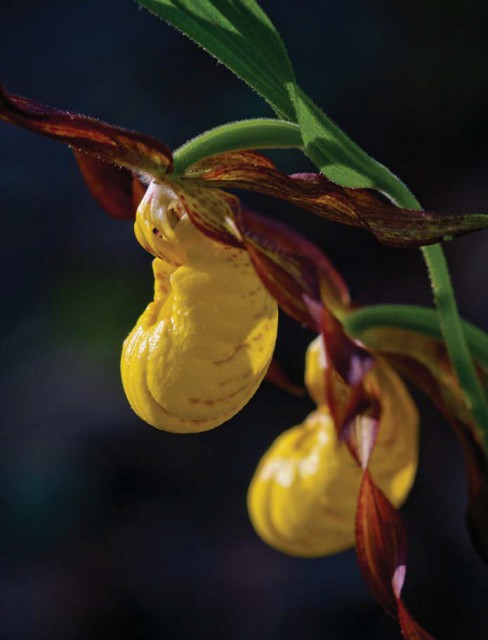On a sunny, but muggy, morning last June, six Game and Parks Commission and Northern Prairies Land Trust biologists gathered at Indian Cave State Park. Our mission for the next two days: trek the park’s rugged, wooded hills in search of the elusive yellow lady’s-slipper orchid (Cypripedium parviflorum). A common and widespread North American species, the yellow lady’sslipper grows in coniferous and deciduous forests and wetlands across much of Canada and the U.S. Nebraska, however, supports only a handful of small populations in Missouri River bluff woodlands near Omaha and southward to the Kansas border.
Until recently, the orchid had not been observed at Indian Cave for several decades and was feared extirpated. Jon Morgenson, Commission horticulturist, and his brother saw several lady’s-slippers in the late 1970s while hiking in the park and a now-retired employee believes he saw a small colony in the mid- 1980s. The orchid was rediscovered, however, in 2012 when an employee stumbled upon a clump of unfamiliar yellow-flowered plants in a remote oak ravine. Luckily she photographed the flowers, which were later identified as the yellow lady’s-slipper orchid. This find prompted our survey to see if other lady’s-slippers might yet survive at Indian Cave.
The morning of our survey, in preparation, we synchronized our GPS settings, reviewed data sheets and applied plenty of bug spray in hopes of staving off the ubiquitous mosquitoes, ticks and chiggers. Our search of low wooded hillsides and draws, the lady’s-slipper’s preferred habitat, began near the known plants. Steep slopes, downed timber and other obstacles quickly ended my illusion of the crew walking evenly-spaced in a neat line as we were soon strewn about. It wasn’t long, however, before my promise of a steak dinner to the first to discover a lady’s-slipper was claimed – the finder would later settle for a six-pack of his favorite beverage.

Gerry Steinauer/Nebraska Game and Parks Commission
After two days of searching, though plenty tired and bug-bitten, we had covered only a few hundred acres of the park’s nearly 2,400 acres of deciduous woodlands. Other commitments precluded us from completing a comprehensive survey of lady’s-slipper in the park, which would require a few weeks. Also, yellow lady’s-slippers can only be surveyed when flowering in late-May through early-June when the up to 16-inch tall plants stand above most other woodland vegetation. At this time, the plant’s height and yellow flowers draws the surveyors’ eye making it easier to find. By late-June, other woodland vegetation overtops the orchid, its flowers wither and it becomes nearly impossible to locate. We found 72 yellow lady’sslippers growing in 13 colonies in the park in addition to several populations of the rare Turk’s cap lily (Lilium canadense). Previously, I had seen this lily only once in the park. For each orchid and lily colony we recorded a GPS point, the number of flowering versus vegetative stems and habitat characteristics. Certainly more lady’sslippers occur at Indian Cave and next summer we will continue our survey. Hopefully, in time, we will have an estimate of the yellow lady’sslipper population at Indian Cave.
Recently, we have begun prescribed burning and tree thinning in the park’s woodlands and by tracking the orchid’s abundance can determine the impact of management on this species. In a similarly managed Iowa oak woodland, the orchid increased in abundance. Commission biologists are also monitoring Indian Cave’s woodland bird populations, overall floral diversity and oak regeneration with the same purpose in mind. In the future, if lady’s-slipper or woodland bird populations decline, for example, we may adjust management, and if they increase, we will stay the course.
A Deceptive Trap
Though charming in appearance, the yellow lady’s-slipper’s sac-like pouch is in reality a deceptive trap for unsuspecting insects, primarily bees. The flower’s bright yellow color draws insects and the emanating scent of fragrant oils entices them to enter the pouch from above in the belief that sweet nectar lies within.
Once inside, the duped insects are discouraged from leaving by the opening’s incurved margin and downward pointing hairs that line the pouch’ s interior. Desperate, some large and forceful insects chew or claw their way out through the pouch’s thick, waxy wall while others eventually perish. There is, however, another, though less obvious, escape route for privileged insects of a specific size, but there is a toll for its use – pollinate the flower.
At the pouch’s rear, located on each side of an elaborate column bearing the flower’s reproductive structures are two small exit holes. In some lady’s-slipper species, these are advertised by two nearby light-transmitting patches on the pouch wall. To exit, the pollinator must traverse one of two narrow passages along each side of the column. Here, the insect is first squeezed against the pollen-receiving stigma where rigid hairs scrape previously-collected pollen off the insect’s back, completing pollination. Still blocking the passage, however, is the flower’s viscid pollen mass attached to a stiff, protruding arm. Pushing past this last obstacle to freedom, the insect is coated with new pollen. The yellow lady’s-slipper’s complex flowers ensure crosspollination between plants.
This article originally appeared in the January/February issue of NEBRASKAland Magazine.
 Nebraskaland Magazine
Nebraskaland Magazine




